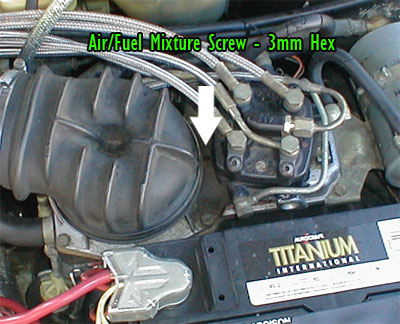Page last Modified:
Wednesday, February 15, 2006 12:41:37 PM - Views

Thanks to Southcross for suggesting this tip
Some Emissions basics: (From
The Nothing)
most emissions are measuring the following
THC - Total HydroCarbons: unburned gas
CO - Carbon Monoxide: burned gas
NOX - oxides of nitrogen: air
common Failing points
THC: if you fail by THC, it is usually the results of overly advanced
Ignition. A couple points back retarded, will help reduce TCH emissions.
Running rich can also lend to a high THC reading, but leaning your
Air/Fuel mix will not necessarily reduce TCH emissions without timing
adjustment
CO: if you fail your CO measurements, you're likely running rich.
Consult the Bentley manual for PROPER Air/Fuel mixture adjustments. CO
outputs are virtually unchangeable via ignition timing.
NOX: if your NOX is excessive, you're most likely running lean. Expect
your THC and Co emissions to be extremely low. Consult the Bentley
manual for PROPER Air/Fuel mixture adjustments. By richening your A/F
mix, your NOX levels will lower and CO will increase, but should not
increase to the point of failure if you follow the correct procedures.
It's the balance of these three that lets the car pass emissions.
Cheap Tips for passing emissions
- Make sure your ignition system is in good working condition - a tune-up (distributor cap, rotor, wires, spark plugs) is a good idea before emissions testing
- Change the Spark Plugs New spark plugs will burn more cleanly than fouled ones, and new spark plugs are cheap, however, if your spark plugs are fouled, you might have other problems as well
- Make sure your engine is equipped with a working catalytic converter if possible
- Make sure your vehicle is fully warmed-up before testing
- Make sure your oxygen sensor is relatively new - they're really cheap - get a universal one
- Retard your ignition timing by ~5° to 10° (this creates a hotter exhaust that prolongs the burn and also helps the catalytic converters to operate at peak efficiency)
- Increase your idle speed slightly - if it idles well at 750 rpm, but stumbles a bit if set lower, set it to about 950-1000 rpm
- Check for vacuum leaks - spray the lines, hoses, gasket areas, intake tubes and brake booster with starter fluid or carb cleaner; if the idle changes when you hit a spot - you have a leak - fix it
- If you have an adjustable electric fan, increase the fan 'ON' temperature to about 200°F to 215°F,
- If you have an oiled 'lifetime' air filter (K&N), replace it with a plain paper filter for testing (the oil in the filter can drive up emissions) A1 CIS air filter - $8, A2 CIS filter - $8, A2 Digifant filter - $12
- Change the oil - this works for some reason - no one really knows. Maybe it's because the blow-by past the piston rings is cleaner? Changing the oil seems to benefit hydrocarbon emissions the most
- Use a camshaft oil baffle - this prevents oil flying off of the cams from going into the air filter - $12 at Parts4VWs.com
Last Resorts: (not recommended at all!)
- Add some alcohol (often available as gasoline anti-freeze) to your fuel tank - start by putting in twice the recommended amount for the anti-freeze. This helps by introducing additional oxygen into the combustion process, ensuring a complete burn, Be careful - this can mess up your oil though
- lean out the air/fuel ratio - this heats up the exhaust, making the catalytic converter work better, If you do this too much - you could make your exhaust glow bright red and burn your pistons and valves [see below]
- Clean the inside of your Throttle body and Intake manifold with Carb cleaner - Remove them from the engine though - you don't want that stuff going where it shouldn't
Adjusting the Air/Fuel Ratio (from BadHabbitRabbit's CIS Adjustment Technote)
Again, consult the Bentley manual for PROPER Air/Fuel mixture adjustments.
DON'T do this unless you have tried everything else in the above
list. In some states this is not legal!
Get a dwell meter - even a cheap one will work fine. Connect it to the
green wire that's tied on the brake distributor - on some cars - it's
tied to the cold start injector.


With your dwell meter plugged in and the car idling, you will see the
needle on the meter bounce. An idle location for the needle to bounce
between is 40 and 50. If the "bounce" is too low, say between 30-40 or
lower, then your bunny is too rich. If the "bounce" is too high, say
between 50-60 or higher, then your bunny is to lean. If the needle
bounce covers a range greater than 10 (say a bounce between 25 and 40)
then you have issues elsewhere.
The screw to adjust the air/fuel ratio is in a hole in between the intake boot and the fuel distributor. Use a 3mm wrench to turn the screw. If the hole is plugged - drill a sheet metal screw into it, and pull it out.
Turning this screw clockwise will make the mixture richer, while
turning the screw counterclockwise will make the mixture leaner. I
recommend turning the screw by half a turn at a time, removing the
screw, accelerate the engine and checking your dwell meter.

Sources:
CapriClubChicago Emmisions;
Megasquirt Manual: Emissions;
Bad Habit Rabbit CIS Adjustment;




